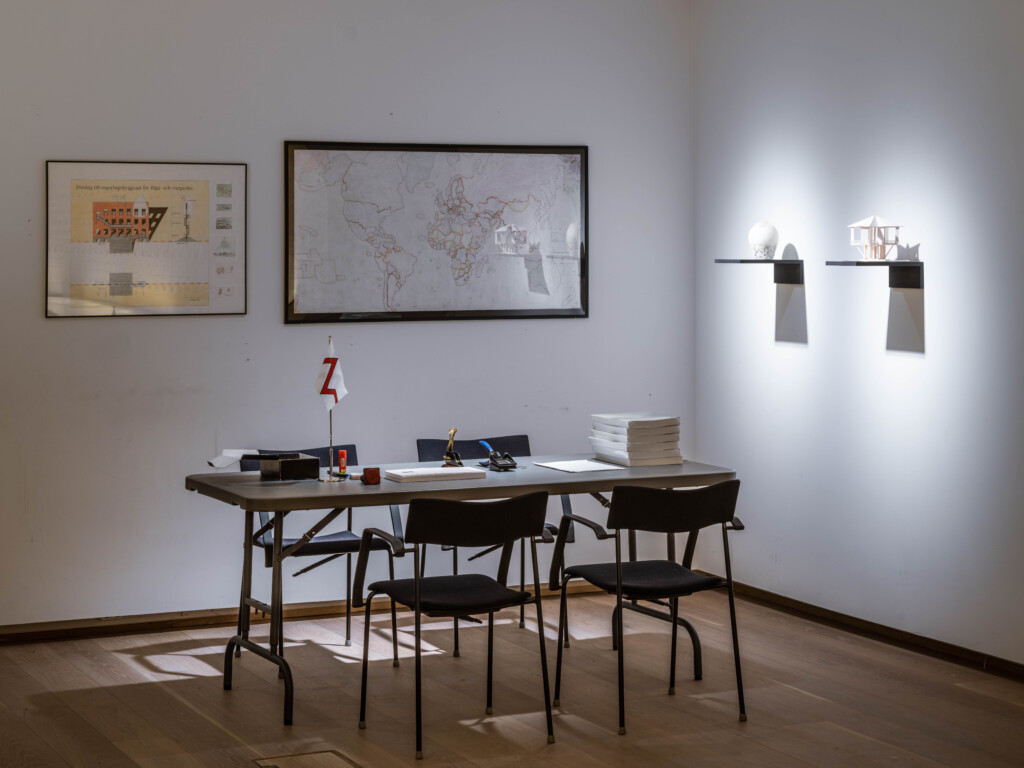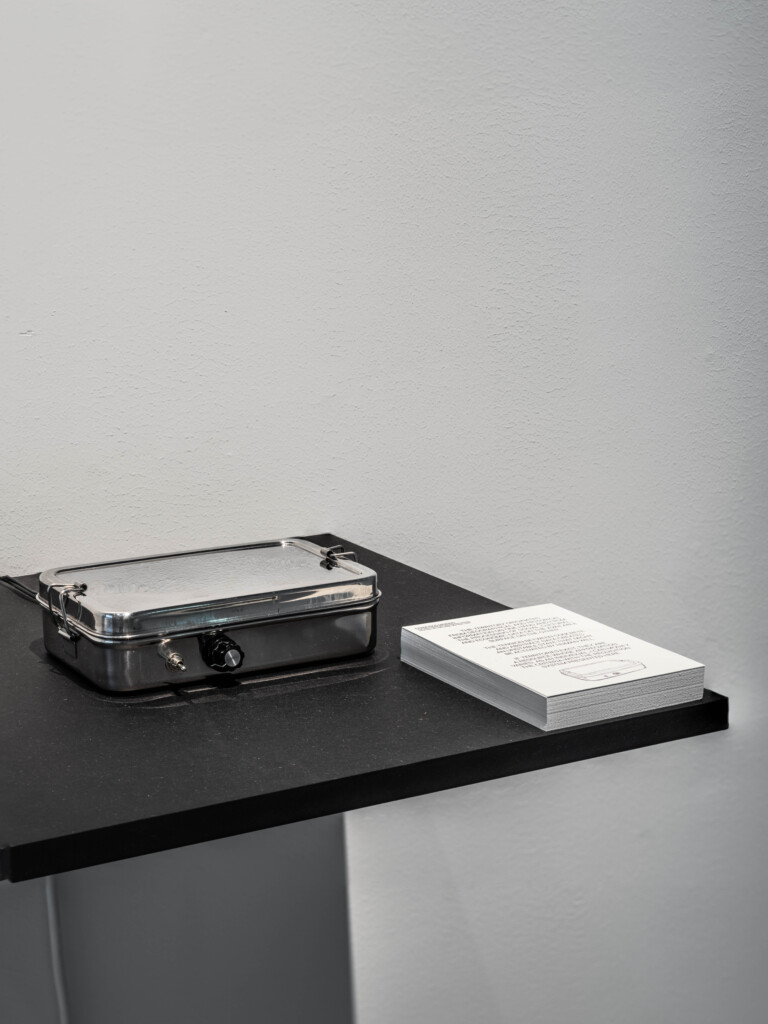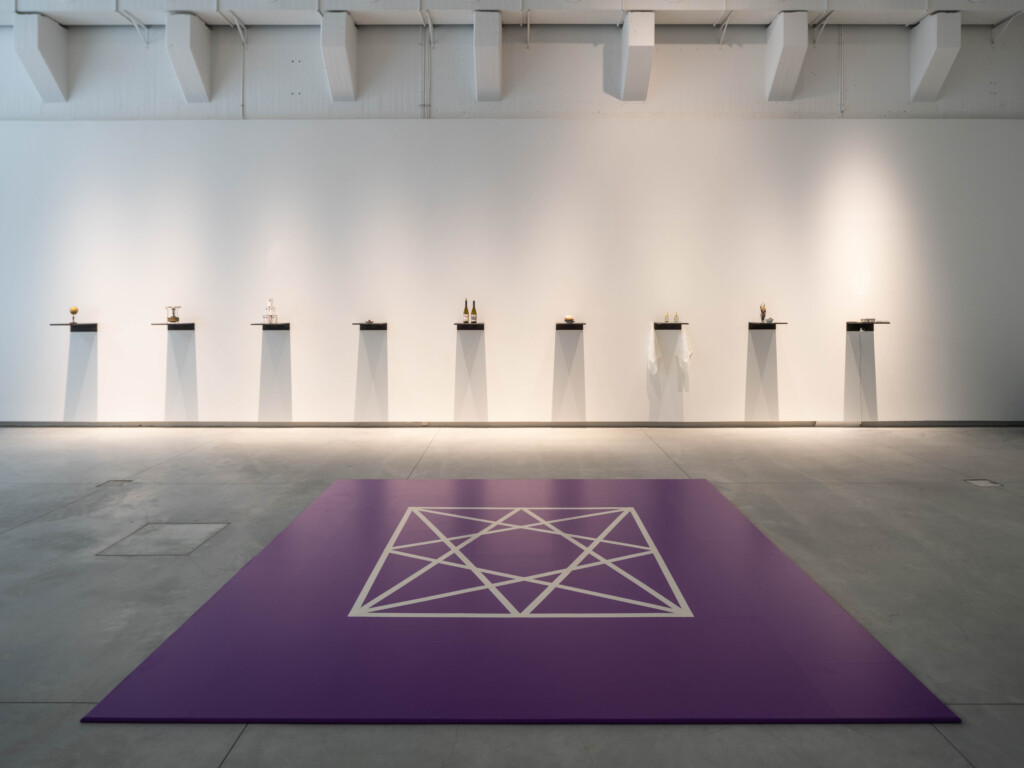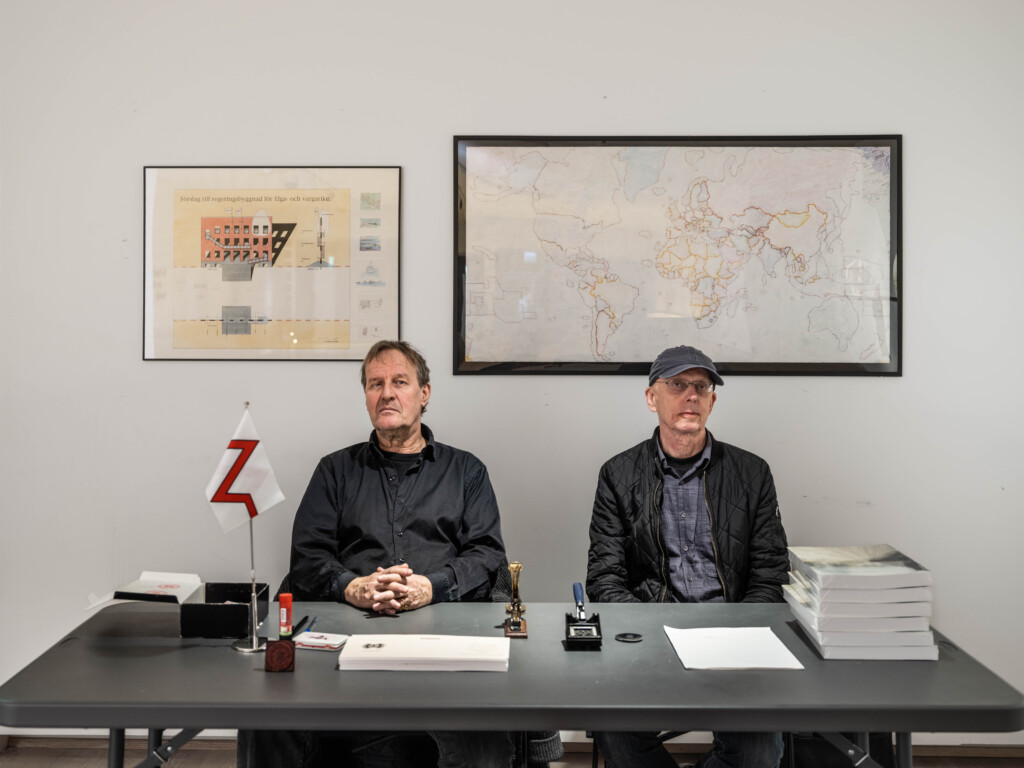Various types of territories and who governs them is the focus of Accelerator’s spring exhibitions. Physical, geographic, juridical, mental and spiritual areas will be explored. It may be national borders and the right to live where one wants, but also territories beyond the domains of humans, life and death.
 The seal of Kingdoms of Elgaland-Vargaland © Leif Elggren och Carl Michael von Hausswolff.
The seal of Kingdoms of Elgaland-Vargaland © Leif Elggren och Carl Michael von Hausswolff.
About the exhibition
Carl Michael von Hausswolff and Leif Elggren’s art project The Kingdoms of Elgaland-Vargaland experiments with the idea of the nation-state. The Kingdoms have been an ongoing art project since their foundation on 27 May 1992. The Kingdoms comprise the world’s geographic, mental and digital borders. WORLD EXPO 2023 presents new works within the framework of Elgaland-Vargaland as well as fragrance works, sound installations, performances and concerts created by artists invited by von Hausswolff and Elggren. A total of 29 artists will participate in the exhibition.
Since the 19th century, World Expos have served to manifest the nation-state and showcase national prestige projects. Elgaland-Vargaland’s World Expo is not a display of progress but rather a presentation of relationships between various places in the Kingdoms that extend beyond time and space. WORLD EXPO 2023 focuses on the communication within the Kingdoms – dialogues among citizens, among the living and the dead, wakefulness and sleep, among earthly and extraterrestrial bodies.
At the heart of WORLD EXPO 2023 is the question of whether a nation can be a nation if it is spread out across the globe and who has the right to define and maintain borders. Elgaland-Vargaland has thus far established embassies and consulates in 39 places throughout the world and continues to annex new territories. The work is a reminder that the geographical and mental borders of a nation are a constantly ongoing performative act that far too frequently decides who lives and who dies. Redrawing maps and changing citizenship requirements are constantly recurring events in contemporary global politics, especially through Russia’s invasion of Ukraine.
The exhibition is curated by Richard Julin and Therese Kellner.
Participants
Leif Elggren, Carl Michael von Hausswolff, Francisco Meirino, Chandra Shukla, Michael Esposito, Helena Schmidt, Joachim Nordwall, Mika Vainio, Pär Thörn, Sten Hanson, Lotta Melin, Birgitta Trotzig, Tobias Kirstein, Zbigniew Karkowski, Anna von Hausswolff, Elfrida Andrée, Sofia Jernberg, Anne-Marie Berglund, Mats Gustafsson, Roberta Settels, Elena Wolay, Lars-Gunnar Bodin, Cecilia Roos, Per Jonsson, Jacob Kirkegaard, Else Marie Pade, Daniel Löwenbrück, Hermann Nitsch and Marja-leena Sillanpää.
Names written in cursive fonts are dead.
Works in the exhibition
Constitution, Passport Office and Paraphernalia, 1992–2023
As the Kingdoms of Elgaland-Vargaland (KREV) are the organisers of the World Expo, the exhibition’s first gallery is devoted to a presentation of the host country, including a substantial quantity of documents and paraphernalia from the activities of Elgaland-Vargaland. There are various expressions of how a nation-state is constructed and how it manifests itself, such as its constitution, currency, important places, its flag, national anthem etc. Like all other countries, Elgaland-Vargaland issues passports and the gallery includes a passport office where visitors can apply for citizenship.
There is also documentation from several important events in Elgaland-Vargaland’s history, including the Kingdom’s application to join the United Nations in 1994, the annexing of Schlaraffenland in 1996 and of Utopia in 2003. When Utopia was annexed, Thomas More’s book Utopia (first published in 1516) was shredded and ground down to make new paper. Schlaraffenland is a mythological land of plenty. The archetype has its roots in Late Antiquity and figured as a motif in 16th-century painting and literature. The dream of a different world order and a better life has existed in various guises throughout human history. Through the annexation, this dream place became a part of Elgaland-Vargaland. Many of the places in Elgaland-Vargaland referred to in this World Expo are realms that cannot be defined by borders or in economic terms such as GDP. These immeasurable countries, such as dreamland or the underworld, are real in Elgaland-Vargaland’s world.
A wall features invoices issued to all the countries of the world for transporting goods through KREV. Capitalism maintains borders. By redirecting the payments to UNHCR, resources are used to support increased freedom of movement for those who are forced to cross borders against their will.




Communication with Nine Extraterrestrial Bodies, 2023
The Kings have processed recordings made by NASA into a composition that, according to the two Monarchs,possesses communicative qualities. The Kings maintain that they are in contact with a large number of celestialbodies, not least when they are dreaming or working on the Elgaland-Vargaland project. Like Pythagoras (ca. 570 BC – 495 BC), the Royal Highnesses are convinced that some of the frequencies they perceive are created by vibrations caused by planets moving around the sun. The idea that the movement of celestial bodies produces tones in harmony with nature and the order of the living is thousands of years old.
Passerelle de Carmignan/Elgaland-Vargaland, 2023
Everyone is welcome to enter or pass through Elgaland-Vargaland. As the Kingdoms comprise places beyond life or no-man’s lands between other countries a bridge or a passage is often required in order to enter or traverse the Kingdoms. For KREV, it is important that people are able to move freely in the world and on several occasions in the history of KREV a system of bridges has been established.
The bridge Passerelle de Carmignan in southern France holds a central place in the exhibition. In 2021, the bridge was handed over to the Kingdoms of Elgaland-Vargaland by the city of Bagnols-sur-Cèze at the request of Helena Schmidt, the Consul General of Elgaland-Vargaland. Schmidt is a teacher at the local art school École de Mont Cotton which the Kings visit annually to meet the students. Together with the students, Schmidt has documented the Kingdoms’ bridge.
Elgaland-Vargaland’s Hierarchical Diagram, 1992/2023
In the middle of the gallery, on a square floor, sits the symbol of Elgaland-Vargaland’s hierarchical diagram. The diagram is inscribed in the constitution, which is presented on the wall in the first gallery. The symbol is a visual palindrome that can be read from all directions, which is also the case of the social order in KREV. All citizens can proclaim themselves King or Queen.
The floor is also the stage area for the performance programme presented during the exhibition. For details, see a separate programme or acceleratorsu.art
Michael Esposito – Sleeping Draughts: The Seven Deadly Sins: Vainglory, Greed, Lust, Envy, Gluttony, Wrath, Sloth, 2023
Soundworks, EVP recordings, by American artist Michael Esposito, are presented on seven shelves. EVP, Electronic Voice Phenomena, was discovered in the 1950s by Friedrich Jürgenson (1903–1987). In 1959, Jürgenson recorded bird song on his tape recorder and on playback heard what appeared to be a human voice. After checking the device and testing new recordings he was of the opinion that he had heard a message from his dead mother. Since then, many have developed methods and equipment to similarly record voices from the other side. An accepted belief is that after at least three hearings, the words of the dead appear.
Under the shelves are printouts of the seven planets that had been discovered by the 17th century when people still held a geocentric world view, meaning that the sun, the moon and the planets revolved around the earth.
Victuals
Various life-giving substances are presented on nine shelves. In the course of the history of Elgaland-Vargaland, the Kings have experimented with basic life-supporting processes such as eating, and its opposite, that is, draining or destructive processes. The decomposition process of the apple, a royal symbol, has been arrested and it is now 13 years old.
KREV’s national dish has been developed based on the idea of a universal dish that could be eaten all over the world and among all social classes. Pasta, ketchup, oil and other ingredients are foodstuffs available in most places in the world.
Elgaland-Vargaland’s national wine is a Côte du Rhône, selected by Consul General Helena Schmidt in conjunction with a ceremony held at KREV’s bridge, which can be seen in the large video projection. The water which the bridge straddles flows into the river Rhône in the district where the wine is produced.
The American experimental composer Chandra Shukla has created two perfumes – one for each Kingdom. Both perfumes contain organic material commonly used in perfumes such as sandalwood, rose, musk and oud. Our sense of smell can prevent us from being poisoned by bad food, alert us to smoke and other dangers. It also plays a major role in our social behaviour, affecting the manner in which we perceive other people.
One of the shelves features the work Portable Territory Requisition System, 2023, by Spanish experimental musician and artist Francisco Meirino. The work is based on article 13 of KREV’s constitution, which states that Elgaland-Vargaland strives to repeal its physical territory and unite the earth into one state. Based on the idea that territories have developed out of disagreements over national borders and culture, Meirino has created an object that emits a trance-like sound, which, according to the Iberian artist and musician, is in conflict with the surface upon which it has been placed.
Elgaland-Vargaland’s National Anthem, 2022
KREV’s national anthem is an appropriation of the 1709 military march Stenbocksmarschen. The composition was chosen as the national anthem because it contains several elements that typically recur in national anthems. According to the Kings, it sounds like many other countries’ national anthems. That which honours one’s own nation also honours other constitutions. There are numerous versions of the national anthem interpreted by citizens. This one was played by the carillon at Tønsberg square in Norway in 2022.
Omni Regi Glans, 1995/2023
Omni Regi Glans is Latin for A Bullet for Each King, which is a watchword with a long history in the annals of KREV. In The Book of the Law, from 1909, British occultist Aleister Crowley (1875–1947) proclaimed that each man and woman is a star. He meant that every person is divine in their essence and that the purpose of our existence is to make our entire being divine. In Elgaland-Vargaland, this is taken to signify that every human being and every life form are of equal value. In the Kingdoms, anyone can proclaim themselves King, as there is a bullet or a sphere or a star for every King. Above the paper is the Coat of Arms of Elgaland-Vargaland.




Performance programme
WORLD EXPO 2023’s performance programme presents works related to artists, choreographers and composers who have passed away. With new interpretations and celebrations, the dead artists’ work lives on in our time.
Francisco Meirino (b. 1975) is a Spanish experimental musician and artist based in Switzerland. His physically intense music explores the tension between programmable material and the potential for its failure in terms of sounds such as transmission failures, magnetic fields and electrostatic noise.
Read more
Joachim Nordwall in relation to Mika Vainio
Pär Thörn in relation to Sten Hanson
Lotta Melin in relation to Birgitta Trotzig
Joachim Nordwall (b. 1975) has, since the end of the 1980s, created electronic and experimental music with a predilection for the psychedelic, the monotonous and circular rhythms, as a soloist and member of various groups. Nordwall runs the record company iDEAL Recordings.
Mika Vainio (1963–2017) was a prominent musician in the genre of Finnish experimental electronic music. From the 1990s to the 2010s, he published music under his own name and under the name Ø, among others. He was a member of the band Pan Sonic.
Pär Thörn (b. 1977) is an author, sound artist and fanzine editor based in Gothenburg. Since his debut in 2002, he has published some twenty books, translated into, among others, Danish and French. In his music performances he frequently combines loops, concrete sounds, voice and pure tones.
Sten Hanson (1936–2017) was a composer, poet and performance artist who was active from the early 1960s. He was a pioneer in experimental text and sound compositions. As a composer, he was an autodidact.
Lotta Melin (b. 1961) is a choreographer and artist based in Stockholm. Death and ephemeral corporal conditions have played a central role in her practice. As a choreographer, she has frequently collaborated with artists, experimental musicians and practitioners of other art forms.
Birgitta Trotzig (1929–2011) was a Swedish author and critic who made her debut in 1951 with a collection of short stories entitled Ur de älskandes liv (From the Life of Those Who Love). She wrote novels, prose poems and poetry. In 1993, she was elected to the Swedish Academy, occupying Seat No 6.
Read more
Tobias Kirstein in relation to Zbigniew Karkowski
Anna von Hausswolff in relation to Elfrida Andrée
Sofia Jernberg in relation to Anne-Marie Berglund
Tobias Kirstein (b. 1972) is an artist, author and composer based in Copenhagen. His work is often focused on sound and power and he has long explored the agency of listening as an aggressive, but invisible, territorial tool.
Zbigniew Karkowski (1958–2013), was a Polish experimental musician and composer who was based in Gothenburg in the 1980s. He composed both electroacoustic music and chamber music, performed by ensembles throughout the world.
Anna von Hausswolff (b. 1986) is a Swedish singer, pianist, organist and composer. Since 2010 she has released five albums that have received widespread attention in Sweden and abroad.
Elfrida Andrée (1841–1929) was a Swedish composer, conductor, Europe’s first woman church organist and Sweden’s first woman telegraphist.
Sofia Jernberg (b. 1983) is a Swedish experimental singer and composer, based in Stockholm. She is interested in exploring the “instrumental” possibilities of the voice and works with singing techniques that frequently break with traditional techniques and conventions.
Anne-Marie Berglund (1952–2020) was a Swedish author born in Finland, who wrote poetry, prose and radio drama, often exploring women’s desire for freedom and liberation.
Read more
Mats Gustafsson in relation to Roberta Settels
Elena Wolay in relation to Lars-Gunnar Bodin
Cecilia Roos in relation to Per Jonsson
Mats Gustafsson (b. 1964) is a saxophonist, improviser and composer based in Nickelsdorf, Austria. Gustafsson composes solo pieces for the saxophone, live electronic and ensemble pieces, and frequently collaborates with musicians in the genres of noise, electronica, free jazz and contemporary rock.
Roberta Settels (1929–2014) was a New York-born composer who moved to Sweden in the 1950s. In the 1960s and 1970s she worked for EMS Elektronmusikstudion in Stockholm, where she composed several pieces of electroacoustic music. Her only LP was dedicated to Ulrike Meinhof.
Elena Wolay (b. 1986) is a music journalist, lecturer and curator of concerts and exhibitions. Since 2011, she has run the platform ´Jazz Är Farlig´ (Jazz Is Dangerous) and has been described as one of the most driving forces for Sweden’s alternative music scene. Afrofuturism has been one of the themes within the business that Wolay has taken up repeatedly.
Lars-Gunnar Bodin (1935–2021) was a Swedish composer, electromusic pioneer, poet and artist. He worked withelectroacoustic music, sound art, concrete poetry, performance and text/sound compositions. He was a driving force at Fylkingen and EMS Elektronmusikstudion in Stockholm.
Cecilia Roos (b. 1958) is Vice-Rector of Research, Professor of Artistic Practices at Stockholm University of the Arts. Roos has a solid background as a dancer, working both nationally and internationally.
Per Jonsson (1956–1998) was a Swedish dancer and choreographer. One of the most important choreographers of Swedish modern dance, his work has been performed at numerous international venues.
Jacob Kirkegaard in relation to Else Marie Pade
Daniel Löwenbrück in relation to Hermann Nitsch
Marja-leena Sillanpää in relation to Alla Döda
Jacob Kirkegaard (b. 1975) is a Danish sound artist whose work reflects on unnoticed or inaccessible aspects of the human condition or civilisation, such as radioactivity or processes related to the death of a human being.
Else Marie Pade (1924 – 2016) was Denmark’s first composer of electronic and concrete music. As an active member of the resistance during the Second World War she was arrested by the Gestapo and spent her time in jail creating the foundation for her electroacoustic compositions.
Daniel Löwenbrück (b. 1974) is a German artist and composer who employs the tape recorder as his primary source of music. He runs the record company Tochnit Aleph, focused on underground noise, actionist sound-art andsound poetry.
Hermann Nitsch (1938–2022) was an Austrian artist and composer. His work encompassed large-scale performances of theatre, multimedia, rituals and enacted violence. He was a leading figure of Viennese Actionism.
Marja-leena Sillanpää (b. 1965) is an interdisciplinary and process-oriented artist, born in Finland and based in Stockholm. The central aspect of her practice is other existing realities, often with historical undertones accentuated by text and sound.
About Leif Elggren and Carl Michael von Hausswolff
Leif Elggren (b. 1950, Linköping) lives and works in Stockholm. Elggren began his career as a visual artist. Since the 1970s he has worked with performance, music and installations, including elements of action. Elggren’s artistic practice is characterised by collaborations, with, among others, Thomas Liljenberg, Kent Tankred and Carl Michael von Hausswolff. Carl Michael von Hausswolff (b. 1956, Linköping) lives and works in Stockholm. Since the end of the 1970s, von Hausswolff has worked as a composer, with sound recordings as his main instrument, and as an artist in the area of conceptual visual art in the form of performance, light and sound installations as well as photography.

Participating artists
Chandra Shukla (b. 1975) is an American experimental musician, composer and artist, based in Asheville, N.C. Under the name Xambuca, he produces electroacoustic music and runs the record company Erototox Decodings. For the exhibition, he has created Elgaland and Vargaland’s perfumes. In his work he practises esoteric and spiritual art, which is the foundation for his interest in olfactory art and perfumes.
Read more.
Michael Esposito (b. 1964) is an American experimental musician and artist who conducts research into Electronic Voice Phenomena (EVP). Especially interested in how EVP relates to experimental music, he combines EVP with related frequency tones and field recordings in order to produce audio-archaeological representations of the sites he explores.
Helena Schmidt is an artist and art teacher. In collaboration with her husband, she has run the art school École de Mont Cotton in Bagnols-sur-Cèze in southern France since 2011. The school is affiliated with Åredalens folkhögskola and collaborates with the Elgaland-Vargaland project. Helena Schmidt is Elgaland-Vargaland’s Consul General in southern France.
Credits
Exhibition team Accelerator
Richard Julin, Curator for the exhibition and Artistic Director.
Therese Kellner, Curator for the exhibition.
A big thank you to Helén Hedensjö and Martin Stenberg at Norrtälje Art Gallery for the loan of display cases.
